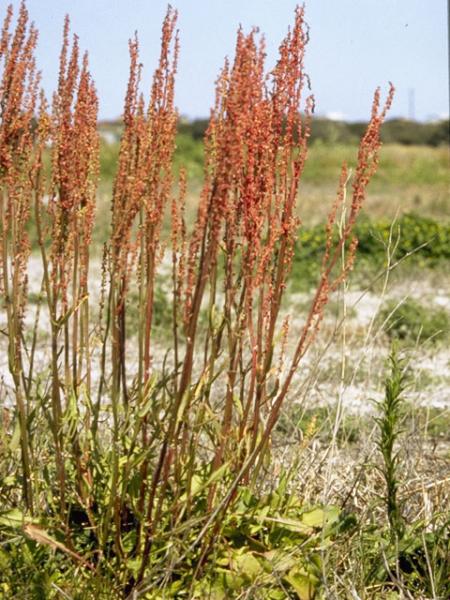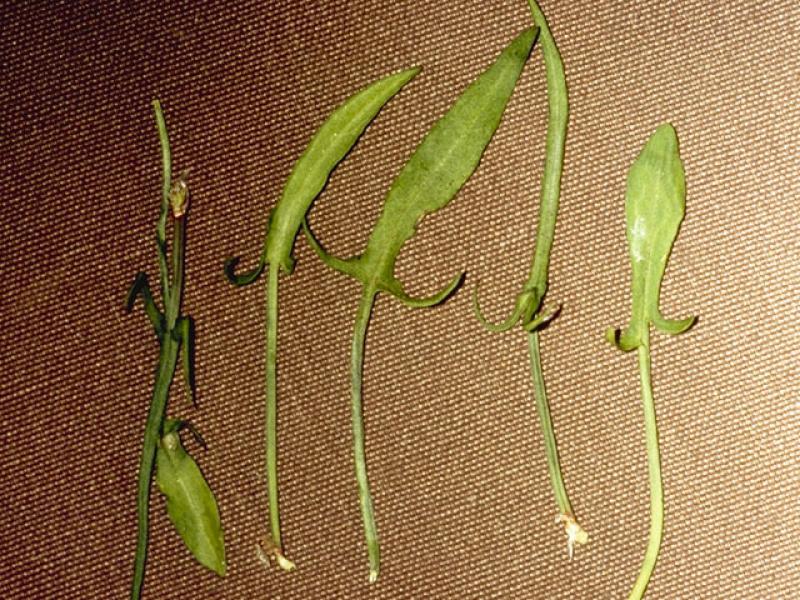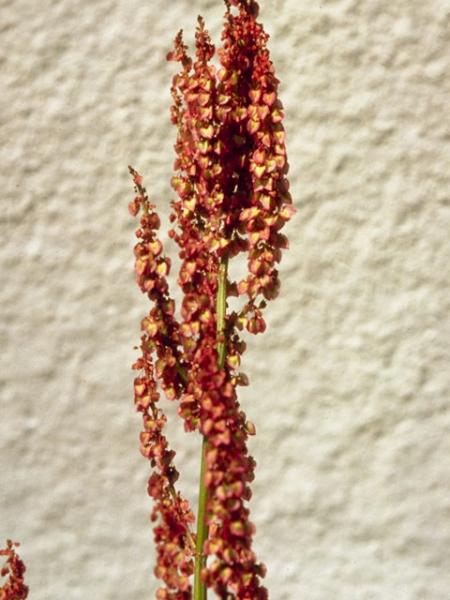Heart Sorrel
Rumex hastatulus Baldw.
- Class
- Dicotyledoneae (Dicots)
- Family
- Polygonaceae (Buckwheat Family)
- State Protection
- Endangered
Listed as Endangered by New York State: in imminent danger of extirpation in New York. For animals, taking, importation, transportation, or possession is prohibited, except under license or permit. For plants, removal or damage without the consent of the landowner is prohibited.
- Federal Protection
- Not Listed
- State Conservation Status Rank
- SH
Historical (Possibly extirpated) in New York - Missing from New York; known only from historical records (more than 30 years ago), but still some possibility of rediscovery upon further searching.
- Global Conservation Status Rank
- G5
Secure globally - Common in the world; widespread and abundant (but may be rare in some parts of its range).
Summary
Did you know?
A historical record from 1929 at Napeague Meadows on Long Island was rediscovered in 1986 and was the only known population in the state. Unfortunately, after many searches in the 2000s, it has not been seen again.
State Ranking Justification
There are no existing populations, although one population on Long Island was known to exist in 1986 but has not been seen since. There are five other historical occurrences mostly from the late 1800s.
Short-term Trends
The short-term trend is apparantly negative. Our only existing population, containing 50-100 plants, has not been seen since 1986. This species may be extirpated in New York.
Long-term Trends
Long-term trends will probably continue at very low levels. This species was always very rare in New York with only five populations known, mostly from the late 1800s and early 1900s. One population was rediscovered in 1986 but is probably extirpated.
Conservation and Management
Threats
The sandy open habitat of this plant may be threatened by woody plant succession or by changes in the depth of the underlying water table.
Conservation Strategies and Management Practices
This species needs disturbance to reduce competition from woody plants or more aggressive herbaceous plants. However, too much direct disturbance to the plants will reduce or eliminate the population. Its habitat could be disturbed after the growing season to open it up for seed germination and colonization but left undisturbed during the growing season.
Research Needs
Research is needed to determine the viability and longevity of the plant's seed bank.
Habitat
Habitat
In New York, Heart Sorrel is known only from brackish meadows and sandy shorelines on Long Island (New York Natural Heritage Program 2010). Dry to moist alluvial and ruderal habitats, river valleys, sandy plains, meadows, waste places (FNA 2005). Sandy soil of the coastal plain (Gleason and Cronquist 1991).
Associated Ecological Communities
- Brackish interdunal swales*
(guide)
Temporarily tidally flooded temperate marshes in interdunal swales dominated by salt-tolerant graminoids. Individual swales occur as small patches positioned between fore-, primary and secondary dunes in a maritime dunes system, typically on barrier islands.
- Brackish meadow*
(guide)
A moist, moderately well-drained brackish (salinity 0.5-18 ppt) perennial grassland with occasional isolated shrubs that is typically situated in a belt at the upper edge of salt marshes bordering sandy uplands, but may occupy large portions of interdunal basins. The community usually develops in areas with a unique combination of soils and hydrology, on deep deposits of periodically windblown or overwashed gleyed sands that are usually flooded only during spring tides and during major coastal storms, approximately two to three times per year.
- Railroad*
A permanent road having a line of steel rails fixed to wood ties and laid on a gravel roadbed that provides a track for cars or equipment drawn by locomotives or propelled by self-contained motors. There may be sparse vegetation rooted in the gravel substrate. The railroad right of way may be maintained by mowing or herbicide spraying.
- Successional northern sandplain grassland*
(guide)
A meadow community that occurs on open sandplains that have been cleared and plowed (for farming or development), and then abandoned. This community is usually dominated by low, dry turf of sedges and grasses less than 30 cm (12 inches) tall, and include patches of open sand and patches of soil covered with mosses and lichens.
* probable association but not confirmed.
Associated Species
- Liatris scariosa
- Myrica pensylvanica
- Panicum virgatum (switch grass)
- Schizachyrium scoparium
Range
New York State Distribution
There are a few specimens from Suffolk County, Long Island, where it was known from one site until the late 1990s. There is also one specimen each from Nassau, Putnam, and St. Lawrence counties. There is an old report from the salt marshes of the Syracuse area.
Global Distribution
This is common in the Southern states from eastern Oklahoma and eastern Texas, east through North Carolina and Florida. There are scattered populations north into Kansas, Missouri, Illinois, Indiana, and also up the East Coast from Virginia to eastern Massachusetts. It is probably extirpated in New Jersey, Pennsylvania, and New York as well as Illinois.
Identification Comments
General Description
Heart Sorrel is a dioecious, tap-rooted perennial herb, growing from 40 to 100 cm tall. The stems branch from the base, and the leaves are spear-shaped ("hastate"), with two often unequal lateral lobes at the base and a central linear or oblong one. Like other members of the buckwheat family, the stems are swollen at the nodes. The flowers are tiny (1 to 3 millimeters), greenish or reddish, and densely packed into a compound infloresence. Upon maturity, the inner tepals of Rumex flowers form structures called valves, surrounding the fruit. The midrib of one of these valves forms a protruding structure called a tubercle. The fruit are brown achenes 1 to 1.5 mm long, enclosed by winged valves 2.5 to 3.5 mm in diameter (FNA 2005).
Best Life Stage for Proper Identification
Fruiting plants are most easily identified, though identification from vegetative material may be possible in some cases.
Similar Species
Rumex acetosella ssp. pyrenaicus and R. acetosa (both non-native species) are the two other Rumex species in New York with hastate or sagittate leaves. R. acetosella ssp. pyrenaicus has slender, creeping roots, and the achenes are closely wrapped by the valves. R. acetosa has mainly sagittate (arrow-shaped) leaves, and midribs of the valves are expanded into grains. Rumex hastatulus has a thick taproot, and its fruits have expanded, wing-like valves, lacking grains (FNA 2005).
Best Time to See
Heart sorrel flowers in June and the fruits are present from late June through July.
- Flowering
- Fruiting
The time of year you would expect to find Heart Sorrel flowering and fruiting in New York.
Heart Sorrel Images
Taxonomy
Heart Sorrel
Rumex hastatulus Baldw.
- Kingdom Plantae
- Phylum Anthophyta
- Class Dicotyledoneae
(Dicots)
- Order Polygonales
- Family Polygonaceae (Buckwheat Family)
- Order Polygonales
- Class Dicotyledoneae
(Dicots)
- Phylum Anthophyta
Additional Common Names
- Red Sorrel
- Sheep Sorrel
- Wild Sorrel
Synonyms
- Rumex engelmannii Meisn.
Additional Resources
Best Identification Reference
Flora of North America Editorial Committee. 2005. Flora of North America North of Mexico, Volume 5, Magnoliophyta: Caryophyllidae, Part 2. Oxford University Press, New York.
Other References
Gleason, Henry A. and A. Cronquist. 1991. Manual of Vascular Plants of Northeastern United States and Adjacent Canada. The New York Botanical Garden, Bronx, New York. 910 pp.
Holmgren, Noel. 1998. The Illustrated Companion to Gleason and Cronquist's Manual. Illustrations of the Vascular Plants of Northeastern United States and Adjacent Canada. The New York Botanical Garden, Bronx, New York.
House, Homer D. 1924. Annotated list of the ferns and flowering plants of New York State. New York State Museum Bulletin 254:1-758.
Mitchell, Richard S. and Gordon C. Tucker. 1997. Revised Checklist of New York State Plants. Contributions to a Flora of New York State. Checklist IV. Bulletin No. 490. New York State Museum. Albany, NY. 400 pp.
Mitchell, Richard S. and J. Kenneth Dean. 1978. Polygonaceae (buckwheat family) of New York State. Contributions to a flora of New York State. Richard S. Mitchell, ed. New York State Museum Bulletin No. 431. 79 pp.
New York Natural Heritage Program. 2010. Biotics database. New York Natural Heritage Program. New York State Department of Environmental Conservation. Albany, NY.
New York Natural Heritage Program. 2024. New York Natural Heritage Program Databases. Albany, NY.
Smith, Gerald A. No date. Bird breeding season survey at El Dorado Beach Preserve 1981-.
Weldy, T. and D. Werier. 2010. New York flora atlas. [S.M. Landry, K.N. Campbell, and L.D. Mabe (original application development), Florida Center for Community Design and Research http://www.fccdr.usf.edu/. University of South Florida http://www.usf.edu/]. New York Flora Association http://newyork.plantatlas.usf.edu/, Albany, New York
Links
About This Guide
This guide was authored by: Stephen M. Young
Information for this guide was last updated on: September 20, 2012
Please cite this page as:
New York Natural Heritage Program. 2024.
Online Conservation Guide for
Rumex hastatulus.
Available from: https://guides.nynhp.org/heart-sorrel/.
Accessed July 27, 2024.


